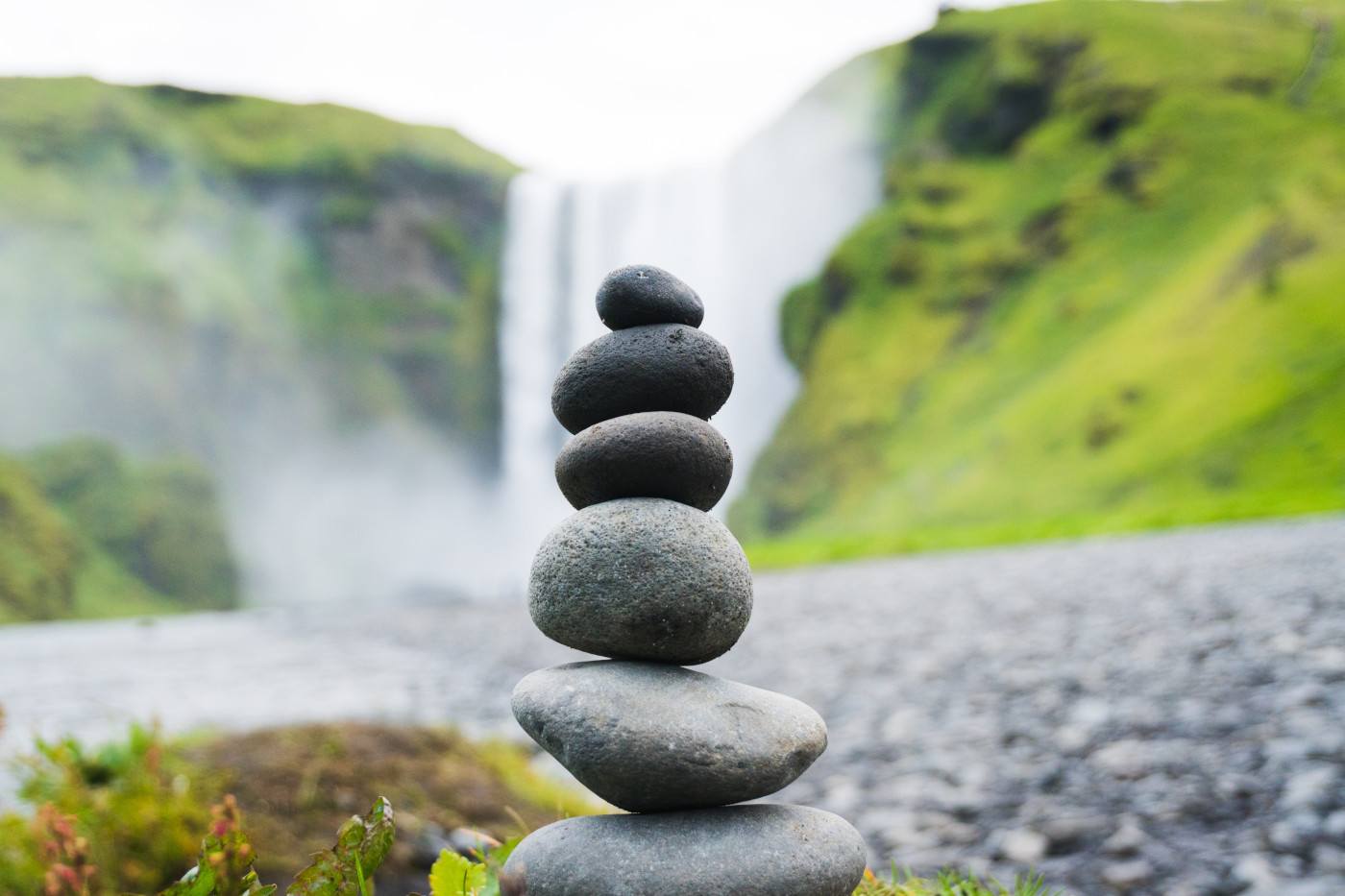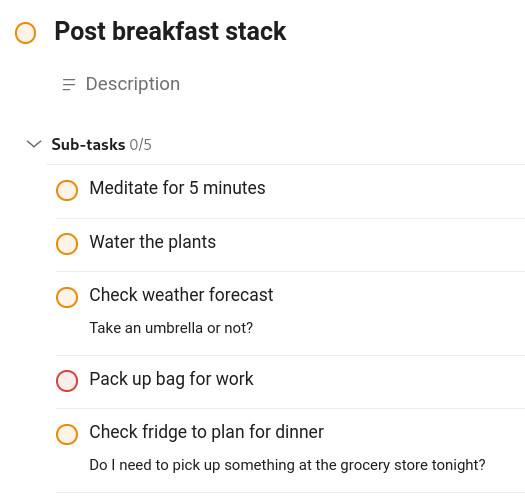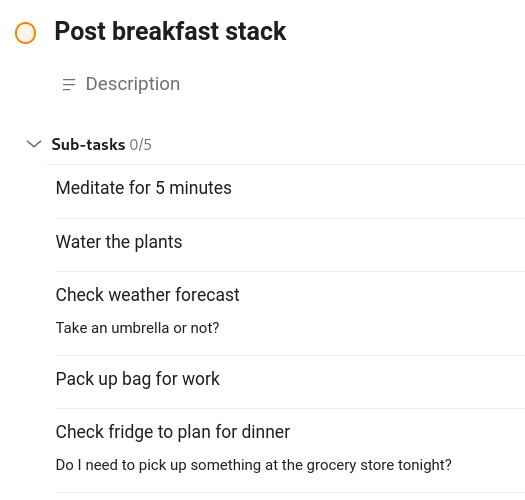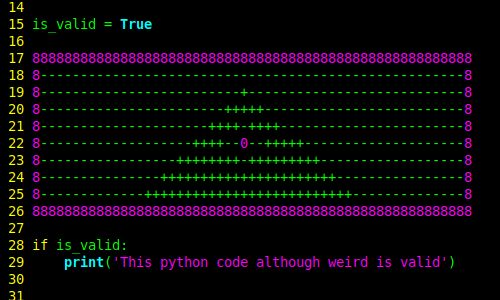Use Todoist to create habit stacks and save mental energy
Everything we do takes time and energy. Even if it’s a tiny amount, there is a cost to it. Just remembering to water your plants everyday costs a bit of mental energy. This tiny amount will add up if you have to remember to do 10-20 mundane tasks each day. That’s without counting the frustration of forgetting to water your plants and killing them!
This may not seem like much but if your daily budget of mental energy is already strained from some big problem or worry in your life, recovering some energy spent on mundane tasks could really help you tackle the real challenges in life. Let’s see one way to get it back.
Batch together mundane tasks in habit stacks
Among all the amazing tips and techniques provided by James Clear in Atomic Habits, the concept of habit stacking particularly resonated with me.
It facilitates the creation of multiple habits by linking them. The idea is to connect together habits by deciding that habit 2 will be performed right after habit 1. For example you commit to watering your plants right after preparing your kid’s breakfast. Then you can connect habit 3 to habit 2, and so on, creating a habit stack. The clear benefit of habit stacks is that you only need one cue to trigger the first habit in the stack and consequently all of the other linked habits. Each habit in the stack, except for the last one, is a trigger for the next habit.
You probably don’t need to be reminded to make your kid’s breakfast, but you keep forgetting to water your plants, and check the weather forecast to know if you need an umbrella today, and make sure you pack your laptop and other notebooks for work that you may have used last night, etc …
By stacking all these somewhat unrelated tasks you can quickly build up multiple habits at once. In return you won’t have to remember to do all of the tasks. Just remember, or better yet use an obvious trigger to do the whole stack!
 Photo credit: Unsplash
Photo credit: Unsplash
At least that’s the theory.
Easier said than done
I see a few challenges with implementing this in practice:
- Some habit connections are easier than others to build up. Checking the weather forecast right after watering plants may be easier due to the water involved in both. But packing your work documents after checking the weather forecast may not be a natural mental connection to create.
- Any distraction can break the chain. Your wife asking you if you glued your kid’s broken toy might be enough of a distraction to forget about the next habit in the stack. Now you are trying to remember if you even have enough glue and when you could glue the toy and the whole stack is gone from your mind. That is the pitfall of chaining habits: if you miss one, you may miss all the following habits too.
- What if you need to build a bunch of tasks as habits as soon as possible. You cannot wait for habit 4 to be an automatism in order to get habit 5 done.
So while I love the idea of habit stacks, I find it challenging in practice. My solution? Building only one simple habit of going through a checklist. That’s where Todoist comes in.
Build your habit stack with Todoist
Todoist, and todo lists in general, are one big organized checklist. To help build and maintain a habit stack, one could simply create each habit of the stack as an individual Todoist task. They could be recurring daily and have a due time set one minute apart, sorting them as intended in the stack when using due date sorting. However a couple of problems arise from this approach:
- The tasks are not connected with one another so the chain is less obvious. It is to easy to jump around tasks or get only a few of them done and skip the annoying ones.
- It may create quite a bit of clutter in your daily todo list if you have big stacks or many stacks, or both.
The solution is to create one task for the habit stack and each habit as subtasks. Now all you need to build is the one habit of looking at this Todoist task and click on it. Once you open it, you see your habit stack and only your habit stack, no distractions, and you are ready to go!

There are actually 2 ways to create your subtasks in Todoist:
- Using regular subtasks
- Using uncompletable subtasks
A habit stack using regular subtasks

When you start going through your habit stack, for example here when you finish your breakfast, you would open your recurring stack task and see the above with the list of subtasks that make your stack. The advantage of this view is that it prevents any distraction from other tasks in your todoist that might get you off track.
As you go through the items in your stack, you can mark them as done to make sure you cover all of them. Then use Todoist sub-task reset feature to automatically reset all the subtasks as not done when you complete the stack task. This way all the items in the stack are cleared and ready to go for another round the next day.
A habit stack using uncompletable subtasks

In Todoist you can create uncompletable tasks
simply by adding a * and space in front of the task name.
Using uncompletable subtasks has one advantage that I personally find essential:
The stack is an indivisible task (one might say an atomic habit).
Not being able to complete in isolation one task forces you to have everything done before you can mark the stack as done.
It helps create a habit stack and goes beyond a simple checklist.
Also with regular tasks, you either have to have your phone in your hand constantly to check off each subtask, or you look at the list of subtasks only at the end and click only on the main task, defeating the purpose of completable subtasks.
Habit stack problems solved!
Regardless of which way you implement your subtasks in your todoist habit stack, the challenges mentioned before are now resolved:
- No need to connect 2 totally unrelated habits in your head, they are now connected through the Todoist task
- If you get distracted, just go back to the list to finish the stack
- The list of subtasks can be very long but created in 5 min and nothing will be missed if you tackle each subtask sequentially
Using Todoist instead of a paper checklist has a couple of advantages:
- If something prevents you from going through the list or from finishing it, the stack task will stay in your Todoist as uncompleted, reminding you that some or all of these subtasks aren’t done, without cluttering your daily task list. Maybe you can do some of these items later that day.
- You can edit and refine the list as you go through it. Maybe an item of the stack needs to be renamed for clarity, or added in the middle of the stack. Do it on the fly on your phone.
More free time and energy for the fun stuff
With all these mundane tasks in your habit stack or stacks, you are now saving an underappreciated amount of time and energy by doing them at the right time without having to remember them all.
Maybe you can spend this extra time and energy on the novel idea you have, or catch up of your backlog of books to read, or spend time playing with your kid(s). Whatever it is, you should add it to one of your habit stacks to make sure the fun stuff doesn’t get sidelined either!
Thank you to Nigel Leadbitter for reviewing this article and providing very useful feedback.





